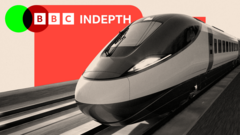Is HS2 Destined for Disaster Due to a National Problem?

Understanding the Challenges of Britain's High-Speed Rail: A Deep Dive into HS2
High-Speed 2 (HS2), the ambitious project aimed at transforming Britain's rail network, has become synonymous with controversy and mismanagement. With costs spiraling and timelines extending, the rail minister's inability to provide clear answers is emblematic of the project's struggles. As we explore the multifaceted challenges HS2 faces, we will uncover the deeper implications of the project on Britain's infrastructure strategy, public sentiment, and the political landscape.
The Origins of HS2: A Vision for the Future
Initially conceived to alleviate congestion on the West Coast Mainline, which spans over 700 miles from London to Glasgow, HS2 was designed to usher in a new era of high-speed travel in the UK. The original vision promised trains capable of reaching 250 mph, significantly faster than existing services. This ambitious goal was rooted in the desire to enhance capacity and efficiency, drawing inspiration from successful high-speed rail networks across Europe and Asia.
Cost Overruns and Delays: A Case Study in Mismanagement
However, the project has encountered significant setbacks. Reports indicate that the line between Birmingham and London, once projected to cost around £33 billion, could now reach an astonishing £81 billion. When adjusted for inflation, experts predict that taxpayers may ultimately foot a bill exceeding £100 billion for just 135 miles of railway. This staggering figure has raised eyebrows and led many to label HS2 as a textbook example of mismanaged infrastructure projects.
Key Factors Behind Cost Overruns
- Mismanagement: Poor oversight and planning have plagued HS2, contributing to its ballooning budget.
- Complex Negotiations: The hybrid bill mechanism used for HS2 allowed extensive public consultations, resulting in costly modifications to the project.
- Geographical Challenges: The UK’s dense population and property ownership issues complicate the construction of large infrastructure projects.
Public Sentiment: Navigating Resistance and Opposition
Throughout the HS2 journey, public sentiment has played a crucial role. Residents in communities affected by the proposed route have voiced concerns about noise, property devaluation, and environmental impacts. The need for extensive negotiations and compensation measures has further complicated the project, leading to delays and increased costs.
Community Engagement and Its Costs
The hybrid bill process allowed individuals and local councils to petition for changes, resulting in a labyrinth of negotiations. While this approach aimed to address community concerns, it has also led to significant financial implications. An analysis revealed that HS2 allocated funds for various requests, from insulating churches to creating new parks, ultimately adding hundreds of millions to the project's overall cost.
Future-Proofing or Misguided Ambition?
One of the core debates surrounding HS2 is whether its ambitions were overly optimistic. While the project's early engineers aspired to create a state-of-the-art railway, critics argue that this vision strayed from the primary goal of increasing network capacity. Andrew Meaney, a transport consultant, suggests that a more pragmatic approach, such as running trains at slower speeds, could have yielded significant cost savings.
Lessons from International Rail Systems
Examining successful high-speed rail systems in countries like France and Japan offers valuable insights. These nations have capitalized on their geographical advantages and streamlined planning processes, resulting in efficient rail networks. In contrast, HS2's trajectory has been marred by bureaucratic hurdles and public opposition, raising questions about the viability of large-scale projects in the UK context.
The Role of Government and Political Will
The UK government has remained committed to HS2 despite the growing uncertainty surrounding costs and timelines. The political implications of backing such a high-profile project can be significant, as public opinion sways and funding priorities shift. The hybrid bill approach, while innovative, has also been criticized for introducing unnecessary complexity into the planning process.
Political Realities and Public Perception
As the project continues to face criticism, the government must grapple with the political realities of infrastructure investment. Public sentiment can shift quickly, and politicians may hesitate to champion projects perceived as flawed or excessively costly. This dynamic raises questions about how future governments will approach transportation infrastructure and whether they will prioritize smaller, more manageable projects over grandiose schemes like HS2.
Conclusion: A Path Forward for Britain's Infrastructure
As HS2 grapples with its challenges, it serves as a microcosm of the broader issues facing infrastructure development in the UK. The questions raised by HS2 extend beyond the specifics of this particular project; they touch upon the very nature of how Britain constructs its future. The complexities of public engagement, political will, and geographical constraints will continue to shape the landscape of infrastructure in the UK.
In navigating the path forward, it is essential to strike a balance between ambition and pragmatism. As the nation contemplates its infrastructure needs, the lessons learned from HS2 will be invaluable in informing future projects and decisions. The question remains: how can Britain effectively address its transport challenges while balancing the needs of communities and the demands of modern infrastructure? #HS2 #Infrastructure #TransportFuture
Frequently Asked Questions
What is HS2 and why was it proposed?
HS2, or High-Speed 2, is a high-speed railway project aimed at increasing capacity and reducing travel times between major cities in the UK, particularly between London and Birmingham. It was proposed to alleviate congestion on existing rail lines and enhance connectivity.
What are the main challenges HS2 has faced?
HS2 has faced multiple challenges, including significant cost overruns, delays in construction, public opposition, and complex planning processes. These factors have contributed to its reputation as a mismanaged project.
How does HS2 compare to high-speed rail systems in other countries?
Unlike high-speed rail systems in countries like France and Japan, which benefit from less bureaucratic red tape and more open land, HS2 has struggled with public engagement and geographical constraints, leading to increased costs and delays.
```Published: 2025-07-20 23:14:05 | Category: technology



